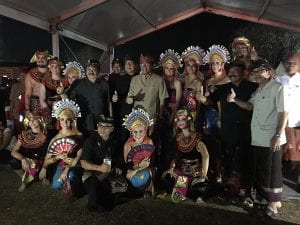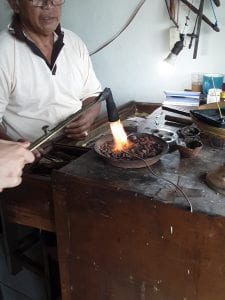So, this post will be technically split up into two parts. All events are set in Kerambitan; however, the first part details some of my lingering experiences with some friends in Java—despite having long left the island. The second looks at how the SIT program involved us in Kerambitan’s art scene.
Now, it is customary for us SIT students to share our college major in our introductions. We’ve had to introduce ourselves many times, and the most general reaction to my declaration that I am an English major is one of amusement. They often mention their confusion over why I study how to speak English if I already speak English—which isn’t untrue, but I would claim that the focus of an English major in America expands on other forms of communication in English than on simply grammatically correct speech. And yet, despite the chuckle that most Indonesians get from my major, there is a strange power here in being an English major, especially in the Pesatrens. Already I have received requests from male students and staff at the Pesantrens to look over their essays for various English assignments, and even for one’s language test to get into an American graduate school. The other English major student in SIT tells me that he has also received such requests. I have never felt so impressed by the power of knowing English and of knowing it well in Indonesia. The responsibility that I feel to not steer these men wrong is sobering. But I guess that’s life. It seems simple, but it is monumental to know that whenever one offers advice, if it’s taken, then one is impacting another person’s life. That is true in America, and it is especially true in Indonesia.
Another subject that I’d like to share with you is about art in Kerambitan. Us SIT students got to participate in a small part of Kerambitan’s art scene in two ways. The first was through a festival for the village, during which we danced on stage for the attendees. The dance is called Jangi Janger, named after the song we were required to sing along with it. I and two other females danced the men’s role because we had an uneven number of male to female students. In comparison to another dance we performed in Java—during which I danced the women’s part in the women’s dress—it was far easier to do everything in the man’s costume. Our dance was simpler and required less skill, the outfit allowed for a far greater range of movement and breath, and we wore the headdress without pain. It was all quite comfortable. However, one discomfort is question about whether our performance toed the line of cultural appropriation. We were dressed in traditional Balinese clothing and danced to an old Balinese song; and yet, I did not understand the cultural significance behind our dress nor of the song. Even now, I still wonder about it, which only incentivizes me to prevent future feelings. One solution I’ve considered is to consistently interrogate exactly why we participate in traditional Indonesian activities. In other words, I feel motivated to understand traditional practices here in Indonesia and what the SIT program expects us to gain from it in order to judge whether or not I can respectfully participate. I am unsure how the program takes cultural appropriation into account about its activities, but it doesn’t hurt to be proactive by asking questions and taking personal responsibility.
The second opportunity to learn about art in Kerambitan was through the program’s arts project. For the arts project, we were individually required to study at least one art form (painting, woodcarving, silver jewelry-making, ceramics, etc) and present our finished products to the group. I decided to learn the silver jewelry-making and focused my attention on how the artist’s creation process was extremely visible to the rest of the community through a large window into the workshop. The artist’s work, from beginning to end, was transparently on display—unlike in America, where the creation process is typically concealed from the consumers’ view. Another takeaway is that everything in Kerambitan—even the most detailed, intricate items—is handmade. People center their whole careers over one art form, and their handiwork is displayed throughout the community—on the townspeople’s’ intricately carved wooden doors, the silver jewelry adorning people’s bodies, the ceramic plates and bowls from which people eat, and much more. Everywhere I go it is awe-inspiring to see such skill.
Thank you, and until next time!


